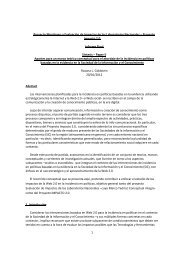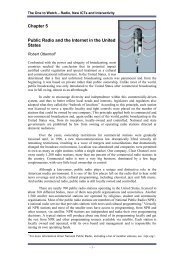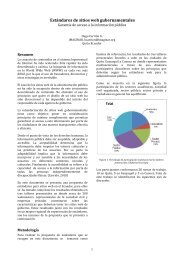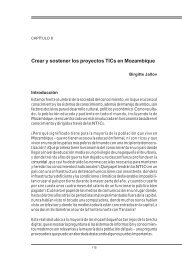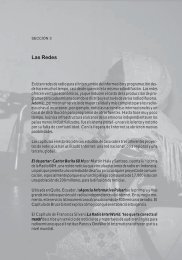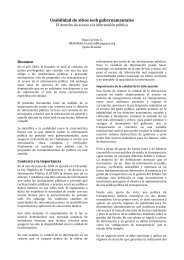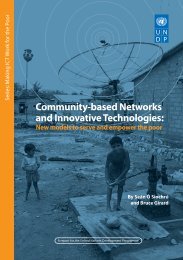Community-based Networks and Innovative Technologies: New ...
Community-based Networks and Innovative Technologies: New ...
Community-based Networks and Innovative Technologies: New ...
Create successful ePaper yourself
Turn your PDF publications into a flip-book with our unique Google optimized e-Paper software.
<strong>New</strong> models to serve <strong>and</strong> empower the poorfor which the community ownership works best. Following this, an explanation of whythe community ownership model is not more widely applied is considered, which also givesus an idea of some of the obstacles to be overcome. Finally, several characteristics mostconducive to the community ownership model are sketched out.4.1 Comparison <strong>and</strong> Compatibility with a Private Enterprise Model.Would a private entrepreneurial model equally or more rapidly address rural <strong>and</strong> low-incomedem<strong>and</strong>, through its capacity to mobilise local sources of capital <strong>and</strong> enterprise?A 2003 ILO study offers a prima facie case that participatory cooperative ownership ingeneral may be better for poverty reduction. The study examined enterprises in somedepth across a range of sectors, <strong>and</strong> concluded with the following:These case studies have shown just how widely the cooperative form can be applied, <strong>and</strong> howit can succeed in helping the poorest <strong>and</strong> most vulnerable people to become organized. Theyshow that, provided the method of development is participatory, the cooperative form isreplicable. Where there are […] for-profit alternatives the cases demonstrate that the cooperativeform is – for the aim of poverty reduction – superior. Where there are no alternatives,it shows that even a relatively weak form of cooperation is better than nothing (Birchall2003 p62).But is there empirical evidence that this applies to extending ICT network infrastructure<strong>and</strong> services to poor communities?Private Entrepreneurial ModelsThe last decade has seen a number of private enterprise <strong>based</strong> attempts to launch a rapidlyreplicable model for broadening access to telecommunication services by harnessinglocal entrepreneurs, often by means of a franchise (see e.g. ITU 2003a Ch 6). The Akshayamodel, as we have seen, incorporates a strong community decision-making influence intothe enterprise <strong>and</strong> its market activities, <strong>and</strong> thus should be considered as a hybrid. Butothers fashion themselves more closely upon the market-driven private enterprise model.One example is the well-known Grameen Phone Village Programme in Bangladesh.Although linked to the non-profit Grameen organisation, 19 it can be classified as a privateenterprise driven model, which obtains finance through the provision of micro-creditfacilities <strong>and</strong> that generates dem<strong>and</strong> by pooling mobile phone use of low-income users.A local entrepreneur (the selection of whom is strongly biased towards poor women)purchases the h<strong>and</strong>set with credit <strong>and</strong> sells on telephony services at affordable rates.Grameen Phone is itself a major mobile phone operator <strong>and</strong> provides the airtime at cost.It thus extends access to telephony to poorer groups within communities, <strong>and</strong> enhancesthe marginal viability of the mobile network by pooling use. But the commercial viabilityof the network as a whole is <strong>based</strong> mainly on the dem<strong>and</strong> of conventional customers,<strong>and</strong> the programme does not extend the area of network coverage per se (although thereare plans afoot to do this).How widely replicable is this experience?38




